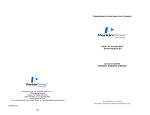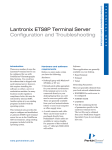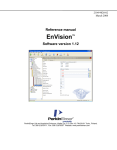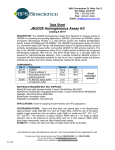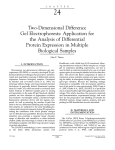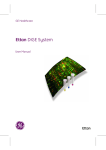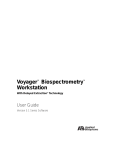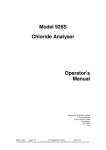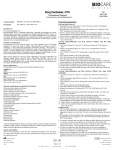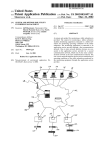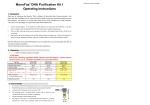Download user manual 4
Transcript
PERKINELMER LIFE AND ANALYTICAL SCIENCES USING THE ALPHASCREENTM PHOSPHOSENSOR KIT CATALOG NUMBERS: 6760307D, 6760307M, 6760307R For Laboratory Use Only Research Chemicals for Research Purposes Only Precautions • AlphaScreen™ beads are light-sensitive. All assays using the AlphaScreen beads should be performed under subdued laboratory lighting of less than 100 lux. Alternatively, green filters (Roscolux filters #389 from Rosco, or equivalent) can be applied to light fixtures. Any incubation of AlphaScreen™ beads should be performed in the dark. Plates can be covered by an opaque microplate to minimize the effect of light. • Due to the small volumes used in the assay, it is recommended that the plates be covered with TopSeal-ATM adhesive sealing film to reduce evaporation during incubation periods (PerkinElmer® Inc., Cat. No. 6005185). The assay can be read with the TopSeal-A film in place. • The PhosphoSensor Acceptor beads contained in this kit may slightly aggregate with time. This is normal. It is advised to vortex the beads prior to use. • Beads should be stored in the dark at 4oC. 2 TABLE OF CONTENTS I. BEFORE STARTING 5 II. INTENDED USE 8 III. PRINCIPLE OF THE ASSAY 8 IV. ASSAY DEVELOPMENT 9 A. Deciding on substrate configuration B. Deciding on assay format C. Titration of biotinylated phosphopeptide and/or non-phosphorylated peptide substrate D. Evaluating optimal enzymatic assay conditions E. Termination of the kinase reaction F. Kinetics of the detection reaction G. Titration of PhosphoSensor Acceptor beads 10 11 13 14 18 20 21 V. SUMMARY OF ASSAY DEVELOPMENT 22 VI. DETAILED PROTOCOLS 24 A. Titration of phosphorylated versus non-phosphorylated substrate B. All-in-one-well and transfer kinase assays C. AlphaScreen beads quality control 24 26 29 VII. 30 TROUBLESHOOTING GUIDE 3 4 I. BEFORE STARTING Receiving the AlphaScreen PhosphoSensor Kit Upon receiving the AlphaScreen PhosphoSensor Kit, ensure that it is on blue ice and that the ice packs are not completely melted. Verify that all components are present in the kit using the table below. Provided Reagents and Materials The following kit sizes are available*: 1,000 assay points (catalog number 6760307D) 10,000 assay points (catalog number 6760307M) 50,000 assay points (catalog number 6760307R) *The number of assay points is based on the use of 500 ng of each bead per well. The reagents and materials provided in the AlphaScreen PhosphoSensor Kit are listed in the Table I: 5 Table I. Reagents and materials supplied 1,000 assay points 6760307D 10,000 assay points 6760307M 50,000 assay points 6760307R PhosphoSensor Acceptor beads 0.1 mL Stored in 100 mM Tris-HCl (5 mg/mL) pH 7.0, 0.05% ProclinTM-300 1.0 mL (5 mg/mL) 5.0 mL (5 mg/mL) Streptavidin-Donor beads 0.1 mL Stored in 100 mM Tris-HCl (5 mg/mL) pH 7.4, 0.05% Proclin-300 1.0 mL (5 mg/mL) 5.0 mL (5 mg/mL) KIT COMPONENTS Positive control bio-LCK-P Stored in 25 mM Hepes pH 7.4, 0.05% Proclin-300 0.05 mL (5 mM) 0.05 mL (5 mM) 0.05 mL (5 mM) 10X Control buffer 100 mM MES pH 6.0, 1M NaCl, 0.05% Proclin-300 1.5 mL (10X) 1.5 mL (10X) 1.5 mL (10X) Note before use: • For maximum recovery of content, briefly centrifuge the vials prior to removing the caps and resuspend the beads by vortexing. • Reagents should be stored at +2 - 8°C. • Acceptor and Donor beads should not be frozen and should be stored protected from light. • 10X buffer may not be suitable as a kinase assay or as a detection buffer. 6 Recommended Additional Reagents and Materials Table II. Recommended reagents and materials Item Suggested source Catalog # Kinase of choice N/A N/A Biotinylated substrate of choice HPLC water or equivalent ATP N/A N/A Fisher Scientific W5-4 Sigma-AldrichTM Co. A-3377 TM MgCl2 Sigma-Aldrich EDTA GIBCO® 15575-038 Staurosporine Sigma-AldrichTM Co. S-4400 OptiPlate™-384 (white opaque 384-well microplate) TopSeal-A Adhesive Sealing Film Tween® 20 PerkinElmer® Inc. 6007290 (pack of 50) 6007299 (pack of 200) PerkinElmer® Inc. 6005185 Pierce Biotechnologies N/A 28320 Single-channel Pipettors§ § Co. M-9272 N/A For lower volume additions (2-10 µL), we recommend a pipet- tor precision ≤ 2%. For higher volume additions (25-1000 µL), a pipettor precision of ≤ 1% is recommended. Assay must be read using an AlphaScreen compatible reader such as all PerkinElmer EnVisionTM multilabel plate readers with AlphaScreen module, Fusion-AlphaTM multilabel readers or AlphaQuest® original AlphaScreen readers. 7 II. INTENDED USE The AlphaScreen PhosphoSensor Kit is intended to perform antibody-free detection of phosphorylated protein or peptide. III. PRINCIPLE OF THE ASSAY In cells, protein kinases mediate the phosphorylation of a variety of different protein substrates in the presence of ATP. Kinases catalyze the reversible addition of phosphate molecules to tyrosine, serine and threonine residues. There are several commercially available antibodies that recognize phosphotyrosine residues with high affinity. However, such generic antibodies are not currently available for phosphoserine and phosphothreonine. The AlphaScreen PhosphoSensor Kit allows detection of the phosphorylation of tyrosine, serine, and threonine residues without the need for such sequence specific antibody. The principle of the assay is illustrated in Figure 1. In this assay, the kinase driven addition of a phosphate group to a biotinylated substrate will result in the simultaneous capture of the phosphorylated substrate by the PhosphoSensor Acceptor (coated with a Lewis Metal Chelate) and the streptavidin (SA) Donor beads. Upon laser excitation of the Donor beads, the proximity of the Donor and PhosphoSensor Acceptor beads will generate an AlphaScreen signal between 520 and 620 nm. In the absence of phosphorylation, no signal should be observed. Since the Acceptor beads allow for the detection of phosphates, the activity of phosphatases can also be monitored using these beads. 8 Biotinylated substrate (Peptide or protein) ATP kinase ADP 1O Emission 520-620 nm 2 LM3+ LM 3 LM Excitation 680 nm + 3+ LM3+ LM3+ Streptavidin Donor Beads Biotinylated Phospho-substrate LM LM3+ LM 3 + 3+ P PhosphoSensor Acceptor Beads Figure 1. Illustration of the detection of a phosphorylated peptide using the AlphaScreen PhosphoSensor Acceptor beads. Legend: LM3+ = Lewis Metal Chelate. IV. ASSAY DEVELOPMENT The AlphaScreen technology has been widely used for the development of kinase assays using specific antibodies. It is important to stress that the optimal detection buffer as well as ATP, substrate, and enzyme concentrations, which have been determined for an antibody based AlphaScreen assay, will not necessarily apply to an antibody-free assay using the PhosphoSensor beads. Consequently, it is strongly advised to follow the assay development steps presented in this section. 9 A. Deciding on substrate configuration The following guidelines should be followed when preparing a novel biotinylated substrate to be included in a kinase assay reaction monitored by the AlphaScreen technology. The same substrate configuration applies for both an antibody-based and an antibody-free kinase assay development using the AlphaScreen technology. 1. Peptide substrate Peptide substrates should be designed such that they possess at least 20 carbons between the biotin label and the amino acid targeted for phosphorylation (tyrosine, serine or threonine). For small peptides, this can be achieved by including either a glycine stretch, or a LC (long chain) spacer. N-hydroxysuccinimidyl ester (NHS) or maleimide driven chemical reaction can be used for the addition of biotin to amino acid sequences. The NHS driven reaction will target the secondary amine present on lysine residues and at the N-terminal of the peptide. On the other hand, the maleimide driven reaction will target the sulphydryl group present in cysteine residues. If the peptide contains many internal lysine residues, which will be targeted by NHS, it is recommended to have biotin integrated during peptide synthesis with the required spacer. 2. Protein substrate Protein substrates can be biotinylated using either NHS or maleimide driven reactions, in the same way as a 10 peptide substrate (see above). However, in order to prevent addition of biotin near the phosphorylation site of the substrate, the presence of lysine or cysteine residues near the phosphorylation site should be evaluated to guide the use of one of the two chemistries (NHS or maleimide driven reaction). B. Deciding on assay format 1. All-in-one-well assay The all-in-one-well (homogenous) assay format represents the format of choice for screening purposes. In this format, the kinase reaction is performed in the same well as the detection reaction (Figure 2). For a detailed protocol description see section VI. In a microplate add: Kinase reaction: Enzyme Inhibitor Biotinylated substrate/ATP mix Incubate at RT 384-well plate Reaction termination: EDTA Incubate at RT Detection reaction: PhosphoSensor Acceptor beads Streptavidin Donor beads Incubate at 1 hour at RT Read with an AlphaScreen capable reader Incubate overnight and read again Figure 2. Scheme of the all-in-one-well assay format. 11 2. Transfer assay The advantage of the transfer assay format is to dilute potential interfering reagents that are present in the kinase reaction before adding the detection beads. This format can also be used for screening purposes. It is especially useful when: • the enzyme is intrinsically highly phosphorylated and therefore interferes with the detection of the phosphorylated peptide by the PhosphoSensor Acceptor beads; • the signal generated is low and high ATP concentrations are required (e.g., over 100 µM). A scheme of the transfer assay protocol is illustrated in Figure 3 (for a detailed protocol description see section VI). Kinase reaction: In a 96-well microplate add: • Biotinylated-substrate • Enzyme • ATP • Incubate at RT • Add EDTA to stop the reaction 96-well plate Dilution of reaction mix: Dilute the reaction mix 1/20 Detection reaction: In a microplate add: • Diluted mix • PhosphoSensor Acceptor beads • Streptavidin Donor beads Incubate 1 hour at RT Read with AlphaScreen capable reader Figure 3. Scheme of the transfer assay format. 12 384-well plate C. Titration of biotinylated phosphopeptide and/or nonphosphorylated peptide substrate To ease the optimization of an antibody-free kinase assay using the AlphaScreen PhosphoSensor Acceptor beads, we recommend obtaining the phosphorylated version of the peptide substrate. Titration of this positive control in parallel with the biotinylated substrate will allow evaluation of the expected signal window. It should be noted, however, that the availability of a phosphorylated peptide is not essential to develop a kinase assay using the AlphaScreen PhosphoSensor Kit. For peptide titration assays, the biotinylated peptide (as well as the phosphopeptide, if available) should be added to the plate diluted in the kinase reaction buffer, whereas the beads (both Acceptor and Donor) should be added to the plate in the detection buffer. For the majority of biotinylated peptides tested, the standard detection buffer composition is: 10 mM Tris‑HCl pH 7.0, 100 mM NaCl, 0.1% Tween-20. However, optimization of the detection buffer must be performed when observing high non-specific binding of the biotinylated substrate. Ionic strength, nature of the buffer, and pH of the detection reaction can influence the nonspecific binding of some peptide sequence. Note 1: Do not use PBS since it contains phosphate, which will bind to the PhosphoSensor Acceptor beads and displace the phosphorylated substrate. Note 2: Be aware that the presence of ATP in the detection reaction may alleviate the non-specific bind- 13 ing of the substrate (see section IV-D). Thus, we do not use plus or minus ATP as an indication of the assay window. D. Evaluating optimal enzymatic assay conditions The following section presents the steps necessary to determine the optimal ATP, substrate, and enzyme concentrations in order to obtain an optimal signal window. The optimal signal window is defined here as the optimum S/B ratio measured between the background signal (basal signal obtained in the presence of staurosporine; see note below) and the maximal enzymatic activity. Note 3: The non-specific binding of some biotinylated peptides will be strongly diminished by the presence, in the detection reaction, of ATP and/ or some enzymes that are themselves phosphorylated for activation. In these cases, control incubations lacking either ATP or enzyme as a reference for background could be misleading when evaluating assay window (S/B values). For such “sticky” peptides, it is advisable to determine assay window using control incubations containing all the reaction components (i.e., enzyme, substrate and ATP) in the presence or absence of a generic protein kinase inhibitor such as staurosporine. Note 4: We do not recommend terminating the kinase reaction using EDTA at this stage of assay development. Since EDTA interferes to some extent with the detection by the PhosphoSensor Acceptor beads, it should be integrated later during assay development (see section IV-E). 14 The following example shows preliminary assay development using the commercially available protein kinase A (PKA) and the biotinylated substrate kemptide. All assays were performed at room temperature (RT), in white, opaque 384‑well microplates, in a final volume of 26 µL using 2 µL of enzyme, 2 µL of biotinylated peptide, 2 µL of ATP, 10 µL of PhosphoSensor Acceptor beads and 10 µL of Streptavidin Donor beads (both acceptor and donor beads were used at a final concentration of 20 µg/mL). 1. ATP/ substrate titration The first optimization step consists of titrating both the substrate and ATP concentrations. We recommend the matrix depicted in Table III, which uses both fixed enzyme (3 nM) and beads concentrations (20 µg/mL). The assay window should be determined by performing the assay in the absence or presence of staurosporine. Table III. Scheme of preliminary kinase assay development. For preliminary assay conditions, perform the titration of ATP and substrate using 3 nM of enzyme. The assay should be performed in the absence and presence of 10 µM of a generic inhibitor (such as staurosporine) with at least one concentration of substrate to evaluate assay background. With 10 µM staurosporine) Substrate (µM) ATP (µM) 0 0.3 1 3 3 3 (3,0) (3, 0.3) (3, 1) (3, 3) (3, 3) 10 (10, 0) (10, 0.3) (10, 1) (10, 3) (10, 3) 30 (30, 0) (30, 0.3) (30, 1) (30, 3) (30, 3) Microplates were read after a detection time of either 1 hour (Figure 4A) or 17 hours (overnight incubation; 15 Figure 4B). After 1 hour of incubation, it was observed that substrate concentrations higher than 0.3 µM did not improve the signal window. A decrease of the signal window was observed for ATP concentrations higher than 3 µM, due to ATP interference. Although similar results were obtained following an incubation period of 17 hours, a greatly improved signal window was observed. Thus, for both incubation periods tested, the optimal signal window was obtained when using 0.3 µM of biotinylated substrate and 3 µM of ATP. Under these conditions, S/B values of approximately 6 and 25 were observed following 1 hour and 17 hours detection time, respectively A AlphaScreen Signal (counts) 30000 [biotin-kemptide] (µM) 0 0.3 1 3 25000 20000 15000 10000 5000 0 0 3 10 30 [ATP] (µM) B [biotin-kemptide] (µM) AlphaScreen Signal (counts) 200000 0 0.3 1 3 175000 150000 125000 100000 75000 50000 25000 0 0 3 10 30 [ATP] (µM) Figure 4. Scheme of the preliminary kinase assay optimization. Kinase reaction was performed in kinase reaction buffer (25 mM Hepes pH 7.4, 100 mM NaCl, 2.5 mM MgCl2, 1 mM DTT, and 0.01% Tween-20) and beads were added in detection buffer (100 mM Tris pH 7.0, 100 mM NaCl, and 0.1% Tween-20). Incubations (25 µL) were conducted in 384-well microplates. Detection time was A) 1hour and B) 17 hours 16 2. Enzyme titration The second optimization step consists of enzyme titration, using the optimal substrate and ATP concentrations determined previously. As observed in Figure 5, increasing the concentration of enzyme up to approximately 0.3 nM led to a proportional signal increase. A S/B ratio of approximately 31 was obtained when using 0.3 nM of enzyme. Above this enzyme concentration, a signal decrease was observed, which may reflect either 1) saturation of both beads (Acceptor and Donor) by an excess of phosphorylated product or 2) competition of biotinylated product binding to the PhosphoSensor Acceptor beads by the kinase itself. As a matter of fact, some kinases are phosphorylated for activation. AlphaScreen Signal (counts) 70000 without staurosporine with staurosporine 60000 50000 40000 30000 20000 10000 0 ∞ -11 -10 -9 -8 -7 -6 log [PKA] (M) Figure 5. Enzyme titration using optimal concentrations of ATP and substrate. PKA was titrated using 3 µM of ATP and 0.3 µM of biotinylated substrate; a detection time of 1 hour was used. 3. Transfer assay format In the transfer assay format, a bulk kinase reaction is performed; subsequently, the reaction mix is diluted before adding the AlphaScreen beads. In this format, the following concentrations of ATP, enzyme and bioti- 17 nylated substrate are suggested as a starting point: 100 µM, 30 nM, and 10 µM, respectively. After incubation of the kinase reaction, the mix is diluted in order to obtain final concentrations of biotinylated substrate between 0 and 1 µM in the detection reaction. The detection reaction using the Acceptor and Donor beads is then conducted as for the all-in-onewell assay format (see section VI-B). E. Termination of the kinase reaction EDTA is a commonly used chelator for termination of kinase reactions. However, excessive concentrations of EDTA should be avoided when performing a detection using the PhosphoSensor Acceptor beads. It is recommended to perform all kinase assay development using 2.5 mM MgCl2 and then to determine the optimal concentration of EDTA required to terminate the enzymatic reaction. If necessary, titration of MgCl2 can also be performed before EDTA titration. Figure 6 shows the effect of increasing concentrations of EDTA on the PKA kinase reaction. In this assay EDTA was added either before starting the kinase reaction or 2 hours following the initiation of the reaction. Detection times of 1 and 17 hours were compared (Figure 6A-B). To confirm the specificity of the reaction, each incubation was performed in the presence or absence of a generic kinase inhibitor (10 µM staurosporine) (data not shown). It was determined that 5 mM EDTA is sufficient to completely stop the kinase reaction, while leaving an acceptable signal window (S/B ratio of 13). Overnight incubation of the detection reaction clearly results in an improved S/B ratio (Figure 6B). 18 AlphaScreen Signal (counts) A 50000 EDTA added at the beginning 40000 EDTA added at the end 30000 20000 10000 0 0.0 2.5 5.0 12.5 25.0 [EDTA] (mM) AlphaScreen Signal (counts) B 1400000 EDTA added at the beginning 1200000 EDTA added at the end 1000000 800000 600000 400000 200000 0 0.0 2.5 5.0 12.5 25.0 [EDTA] (mM) Figure 6. Titration of EDTA. Following the addition of EDTA, a detection time of 1 hour (A) or 17 hours (B) was used. If no signal window is obtainable when using EDTA, it is recommended to either use the transfer assay to dilute EDTA before reading, or to add staurosporine at 1-10 µM to terminate the enzymatic reaction. 19 F. Kinetics of the detection reaction Phosphopeptide detection using the PhosphoSensor Acceptor beads involves lower binding affinities than an antibody-based detection method. Thus, following termination of the kinase activity, it is recommended to incubate the detection reaction overnight to obtain the optimal signal window. Figure 7 depicts the kinetics of the detection reaction following termination of PKA activity with 5 mM of EDTA. A proportional increase in the signal window was observed as a function of time. AlphaScreen Signal (counts) 1500000 with staurosporine without staurosporine 1250000 1000000 750000 500000 250000 0 0 10 20 30 40 50 60 time (h) Figure 7. Kinetics of the detection reaction using the PhosphoSensor Acceptor beads to perform antibody-free kinase activity detection. The signal to background ratio is defined with or without 10 µM staurosporine. Note 5: The time course of the detection will vary for other peptide or protein substrates. 20 G. Titration of PhosphoSensor Acceptor beads In general, it is recommended to use a final concentration 20 µg/mL of AlphaScreen beads per reaction. However, for kinases which have affinities for ATP in the high micromolar range, tolerance of the PhosphoSensor Acceptor beads to ATP can be improved by increasing their concentration in the detection reaction. The following table shows an example using phosphorylation of the biotinylated–crosstide peptide substrate by MSK-1 (Table III). When the concentration of beads was increased to 50 µg/mL, more than two-fold increase in S/B was observed. Table III. Effect of Acceptor beads concentration on tolerance to ATP. In this reaction, 0.3 µM of biotinylated crosstide was phosphoryated by 3 nM of MSK-1 in the presence of different concentration of ATP. Enzymatic reactions were allowed to proceed for 2 hours in the absence (max) or presence (min) of staurosporine. Detection was performed using different bead concentrations, as indicated. [PhosphoSensor Acceptor beads] 20 µg/mL [ATP] (µM) 0 10 30 100 min 21395 7897 6348 6315 max 43965 110645 54727 23108 50 µg/mL S/B 2.1 14 9 4 21 min 262727 26400 19214 15102 max 227959 970873 447904 113449 S/B 1 37 23 8 V. SUMMARY OF ASSAY DEVELOPMENT Figure 9 illustrates the different steps that should be undertaken in the development of a kinase assay using the AlphaScreen PhosphoSensor Kit. In summary, the development of a kinase assay involves the following steps: A. Identify substrate and perform the appropriate biotinylation (see section IV-A). B. Perform titration of the biotinylated substrate together with the phosphorylated version of the substrate (if available) to evaluate the expected signal window (see section IV-C). C1. If a high background signal is observed due to non-specific binding of the biotinylated substrate, optimize the detection buffer. Note 6: Be aware that the presence of ATP in the detection reaction may alleviate the non-specific binding of the substrate (see section IV-D). Thus, we do not use plus or minus ATP as an indication of the assay window. C2. If the peptide titration assay generates a specific signal window, continue with the kinase assay development using an all-in-one-well assay format (see sections IV-D, E, and F). D. Titrate substrate, ATP and enzyme using an all-in-one-well kinase assay format. If a specific signal is observed in the kinase assay, proceed with assay optimization (see sections IV-D, E, and F). 22 E. If no specific signal is observed in the kinase assay, perform the assay in a transfer format to eliminate possible interferences with the detection reaction. A. Choose substrate biotinylation strategy Perform substrate biotinylation B. Titrate of substrate and phoshorylated substrate (if available) C1. Specific window with high non-specific background C2. Specific window observed with low non-specific background Determine optimal buffer to reduce non-specific binding D. Titrate kinase reagents using all-in-onewell format Signal generated No signal generated Determine MgCl2 requirements E. Perform transfer assay to eliminate possible interferences Include EDTA to terminate kinase activity Determine optimal detection time Figure 9. Scheme of assay development using the AlphaScreen PhosphoSensor Kit. 23 VI. DETAILED PROTOCOLS A. Titration of phosphorylated versus nonphosphorylated substrate Protocol suggested for optimizing buffer conditions using phosphorylated and non-phosphorylated substrates (see section III-C): the following protocol will allow the titration of both the phosphorylated and non-phosphorylated peptides. For performing more than two titration curves, increase the volume of each reagent. 1. Prepare reaction buffer 2. Prepare detection buffer: 10 mM Tris pH 7.0, 100 mM NaCl, 0.1% Tween-20. 3. Prepare biotin-non-phospho and biotin-phospho sub- strate by making serial dilutions in kinase reaction buffer supplemented with ATP and EDTA. Note 7: Supplementation with ATP and EDTA is necessary to mimic closely the conditions that will be observed in an actual kinase assay. Table IV shows an example of peptide dilution using a peptide stock at 50 µM. 24 Table IV. Example of peptide dilution using a peptide stock at 50 µmol/L Dilution [final in assay] (mol/L) [intermediate ] (mol/L) 1 1 X 10-6 5.0 X 10-6 -7 -6 2 3 4 5 6 7 8 9 10 11 12 3 X 10 1 X 10-7 3 X 10-8 1 X 10-8 3 X 10-9 1 X 10-9 3 X 10-10 1 X 10-10 3 X 10-11 1 X 10-11 - 1.5 X 10 5.0 X 10-7 1.5 X 10-7 5.0 X 10-8 1.5 X 10-8 5.0 X 10-9 1.5 X 10-9 5.0 X 10-10 1.5 X 10-10 5.0 X 10-11 - Volume of dilution (µL) 20 of 50 µmol/L 60 of dil 1 60 of dil 2 60 of dil 3 60 of dil 4 60 of dil 5 60 of dil 6 60 of dil 7 60 of dil 8 60 of dil 9 60 of dil 10 - Kinase reaction buffer (µL) 180 140 120 140 120 140 120 140 120 140 120 100 4. Dilute the PhosphoSensor Acceptor beads 1/100 in the detection buffer 5. Dilute the Streptavidin Donor beads 1/100 in the detection buffer 6. Protocol of addition The assay is performed in triplicates in a white OptiPlate-384 in a total volume of 25 µL: a) Add 5 µL of the biotinylated peptide dilution b) Add 10 µL of PhosphoSensor Acceptor beads dilution (20 µg/mL final concentration) c) Add 10 µL of Streptavidin Donor beads dilution (20 µg/mL final concentration) d) Incubate in the dark for 1 hour at room temperature e) Read on an AlphaScreen reader 25 B. All-in-one-well and transfer kinase assays These assays are divided into three major steps: Kinase reaction It is recommended but not always necessary to perform the kinase reaction in the smallest volume possible (e.g. 6 µL) to allow for dilution of potential interferences during the detection reaction. Termination of kinase activity Before adding the detection beads, it is recommended to terminate the kinase reaction by the addition of EDTA (diluted in the optimal detection buffer). For the concentration to use in the assay, see section IV-E. If the signal window is too low using EDTA, it is recommended to use a generic inhibitor such as staurosporine to terminate the enzymatic reaction. A titration should be performed to determine the optimal staurosporine concentration. Detection reaction Beads are added following the inactivation of the kinase. It is recommended to use an overnight detection to increase the signal window. This will not affect the pharmacological parameters of the assay since the enzyme has been inactivated before the final detection step. For detection buffer composition, see section IV-C. Note 8: Acceptor beads can be titrated to increase tolerance to ATP (See Section IV-G). 26 1. Prepare reaction buffer as suggested by the provider of the enzyme. 2. Prepare detection buffer: 10 mM Tris pH 7.0, 100 mM NaCl, 0.1% Tween-20. 3. Protocol of addition for the all-in-one-well assay The assay is performed in triplicates in a white OptiPlate-384 in a total volume of 28 µL: a) Add 2 µL of enzyme diluted in the kinase reaction buffer b) Add 2 µL of inhibitor or buffer diluted in the kinase reaction buffer c) Add 2 µL of biotinylated substrate/ATP dilution mix diluted in the kinase reaction buffer d) Incubate 2 hours (kinase dependent) at room temperature e) Add 2 µL of EDTA diluted in the optimal detection buffer f) Add 10 µL of PhosphoSensor Acceptor beads diluted 1/90 in the optimal detection buffer g) Add 10 µL of Streptavidin Donor beads diluted 1/90 in the optimal detection buffer h) Incubate in the dark for 1 hr at room temperature i) Read on an AlphaScreen reader j) Incubate overnight in the dark and read again. Note 9: Detection reaction should read after an overnight incubation for optimal results. 27 4. Protocol for the transfer assay a) Enzyme, substrate and ATP are mixed together in a total volume of 100 µL of kinase reaction buffer (for reagents concentrations see section IV-D) b) The mixture is incubated for 2 hours (kinase dependent) at room temperature (see section IV-E) c) EDTA is added to the mixture d) The kinase reaction mixture is diluted as described in Table V Table V. Dilution of the kinase mixture 1 Volume of dilution (µL) reaction mix Kinase reaction buffer (µL) - 2 30 of reaction mix 70 3 30 of dilution 2 60 4 30 of dilution 3 70 5 30 of dilution 4 60 6 - 100 Dilution e) Dilute PhosphoSensor Acceptor beads 1/100 in the optimal detection buffer in order to get a final concentration of 20 ug/mL f) Dilute Streptavidin Donor beads 1/100 in the optimal detection bufferin order to get a final concentration of 20 ug/mL g) Add in triplicates to the wells of an Optiplate-384 microplate: • 5 µL of kinase reaction dilution (step d) • 10 µL of Acceptor beads dilution (step e) • 10 µL of Donor beads dilution (step f) 28 h) Incubate in the dark for 1 hour at room temperature i) Read on an AlphaScreen reader j) Incubate overnight in the dark and read again C. AlphaScreen beads quality control 1. Prepare 1X control buffer: dilute 1.5 mL of 10X control buffer with 13.35 mL of H2O and add 0.15 mL Tween-20 10%. 2. Prepare serial dilutions of the kit’s positive control at 5µM (Table VI): Table VI: Kit’s positive control probe dilution using a peptide stock at 5 µmol/L Dilution [final in assay] (mol/L) [intermediate ] (mol/L) 1 1 X 10-7 5.0 X 10-7 2 3 4 5 6 7 8 9 10 3 X 10-8 1 X 10-8 3 X 10-9 1 X 10-9 3 X 10-10 1 X 10-10 3 X 10-11 1 X 10-11 - 1.5 X 10-7 5.0 X 10-8 1.5 X 10-8 5.0 X 10-9 1.5 X 10-9 5.0 X 10-10 1.5 X 10-10 5.0 X 10-11 0.00 Volume of dilution (µL) 20 of 5 µmol/L 60 of dil 1 60 of dil 2 60 of dil 3 60 of dil 4 60 of dil 5 60 of dil 6 60 of dil 7 60 of dil 8 0 1X control buffer (µL) 180 140 120 140 120 140 120 140 120 200 3. Dilute the PhosphoSensor Acceptor beads 1/100 in the 1X control buffer 4. Dilute the Streptavidin Donor beads 1/100 in 1X control buffer 29 5. Protocol of addition: The assay is performed in triplicates in a white OptiPlate-384 in a total volume of 25 µL a) Add 5 µL of control phosphopeptide b) Add 10 µL of PhosphoSensor Acceptor beads dilution (20 µg/mL final concentration) c) Add 10 µL of Streptavidin Donor beads dilution (20 µg/mL final concentration) d) Incubate in the dark for 1 hour at room temperature e) Read on an AlphaScreen reader h) Incubate overnight in the dark and read again. Note 10: The 10X detection buffer included in the kit may not be suitable for the detection of all phosphorylated peptides and should only be used for quality control of the beads. Expected results: maximum signal should be reached at 30 nM of control probe with an EC50 between 1.5 to 15 nM. The absolute maximum counts generated will be dependent on the instrument used for the readout. VII. TROUBLESHOOTING GUIDE The following section describes the possible problems which could be encountered when developing an antibody-free kinase assay using the AlphaScreen Technology. If more information is required, please consult your local PerkinElmer technical support division (see page 34 for customer support information). 30 Problem No signal Possible Cause Detection conditions Effect/Remedy Interference of EDTA with the assay / since EDTA is used to chelate the Mg ions, titrate MgCl2 to limit the concentration of EDTA added for chelation. Add a small volume of EDTA before adding the larger volumes of beads. Stop the kinase reaction using a generic inhibitor such as staurosporine (1-10 µM) ATP interferes with the detection 1) Increase the concentration of Acceptor beads to increase the tolerance of the assay to ATP. 2) Perform the assay in a transfer assay. 3) Perform kinase assay in smaller volume and/or detection assay in large volume to increase the dilution of ATP before the detection. Kinase assay conditions Perform the assay in a transfer format to evaluate if it is due to interference of ATP and/or enzyme. Instrument/plates Incompatible microplate choice / use solid opaque white plates such as PerkinElmer Optiplates. Ensure that your reader contains an AlphaScreen reading mode. Kinase assay reagents No or improper biotinylation of substrate peptide or protein / check extent of biotinylation using the AlphaScreen TruHitTM kit (Cat. No 6760627). 31 Problem No signal Possible Cause Kinase assay reagents Effect/Remedy Verify that the distance between the phosphorylated amino acid and the biotin is at least 20 carbons. Protein contains lysine residues near the phosphorylation site / target cysteines for biotinylation using maleimide driven coupling reaction. Cofactor required for optimal enzymatic activity / add the cofactor in the kinase reaction buffer. Peptide substrate not sufficient for efficient phosphorylation by the enzyme / use the full length or a longer domain as substrate. Reagents degradation / perform the assay with fresh enzyme and/or substrate. High background signal Detection conditions Non-phosphorylated peptide is binding non-specifically to the PhosphoSensor Acceptor beads / test different buffer conditions to reduce non-specific binding by varying: • pH (6 to 8) • NaCl from 0 to 400 mM • Tween-20 from 0 to 0.1% and by evaluating Tris-HCl, HEPES or MES as potential buffers. Kinase assay reagents Ensure that the signal to background ratio is established in the presence and absence of staurosporine, since the presence of ATP and/or enzyme in the reaction could alleviate the substrate non-specific binding to the PhosphoSensor Acceptor beads. 32 Problem High background signal Possible Cause Kinase assay reagents High degree Microplates of signal variability Effect/Remedy When using a full-length kinase as a substrate, ensure that it is not activated by phosphorylation. Only use non-activated kinase as a substrate. Warped or distorted microplates / avoid storage of microplate under heavy objects or next to sources of heat. Uneven plate molding. Light penetrating edges of microplate / ensure use of black cover plate during bead incubation. Incubate microplate in dark environment such as inside a drawer or cover microplate entirely with foil or material impenetrable to light. Poorly fitted plate seals inducing evaporation of reaction mixture. Instrument Temperature control problem within the instrument / for the EnVision readers using the 1.07 software version, adjust the internal temperature of the instrument. For other readers, consult the technical service department. Assay conditions Beads are interacting together / Avoid premixing the Acceptor and Donor beads since signal will decrease substantially following 15 minutes of pre-incubation. Day-to-day variability Inappropriate standard operation procedures / ensure that experimental procedures are the same from day to day: 1) prepare the beads in the same area, 2) ensure that incubation times are constant and temperature does not fluctuate in the room. 33 MANUFACTURED BY: PerkinElmer BioSignal, Inc. 1744, William Street Montreal, Quebec Canada H3J 1R4 For further technical information or to place an order, call: PerkinElmer LAS, Inc. 710 Bridgeport Avenue Shelton, CT 06484 USA 800-762-4000 or 203-925-4600 [email protected] European Headquarters: PerkinElmer LAS, Inc. Imperiastraat 8 BE-1930 Zaventem Belgium [email protected] Country Austria Belgium Denmark France Germany Italy Netherlands Norway Spain Sweden Switzerland United Kingdom Telephone 0800 293 515 0800 94 540 80 88 3477 0800 90 77 62 0800 1 81 00 32 0800 79 03 10 0800 02 23 042 800 11 947 900 973 255 020 79 07 35 0800 55 50 27 0800 89 60 46 34 35 PerkinElmer Life and Analytical Sciences, Inc. 710 Bridgeport Avenue Shelton, CT 06484-4794 USA (800) 762-4000 or (+1) 203-925-4602 www.perkinelmer.com For a complete listing of our global offices, visit www.perkinelmer.com/lasoffices M-6760307-01 36




































